The Subtle Art Of Following Up With Email Automation
How to massage your prospects into giving a f*ck, automagically.

So.
You found yourself some juicy leads using clever social media tactics and growth hacks.
You reached out with an awesome cold email that almost looks handwritten, but was actually sent out in automated batches while you were sound asleep, using data and a cold email automation tool.
You hit a sweet spot with one of your prospects and they shoot you an email back.
Scrap that.
Because you’ve been sending thousands of those emails, hundreds of your prospects are shooting you emails back.
Now what, genius?
If you have a reply rate of about 3% and use email automation to scale your outreach from 10 to 300 emails a day, you’ll have yourself 270 new leads to follow up on every month.
Every single one of these require your value, nurturing, patience and availability to be turned into a deal. In fact, statistics show 80% of sales require at least five follow-ups, meaning you’re going to have to send more than a thousand emails to give all those prospects the attention they deserve.
In short: if you’re not up for the task, automation will bury you in the ground rather than shoot you to the stars.
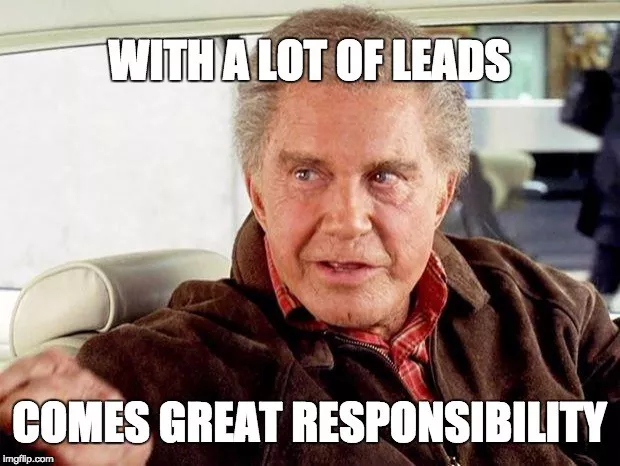
This post is not about the importance of following up and it’s not merely about how to follow up. It’s about how to be smart about it, how to build a maximum amount of fruitful human relations without drowning in your own pipeline, how to do more with less.

Let’s start with the ‘why’
Why bother following up?
Well, because it works. Following up gets you sales.
Statistics show 80% of sales are made after at least five follow-ups.
Statistics also show 44% of sales reps give up after the first rejection.
It gets better:
- 22% stop following-up after two rejections
- 14% stop following-up after three
- 12% stop following-up after four
👉🏼 92% of sales reps give up before the crucial fifth follow-up.
You read that right: you can beat 92% of sales reps by just being persistent.
That’s easier said than done though. Most sales reps know they should follow up consistently, but are afraid to do so. Afraid of being rejected.
Sending countless emails to someone to then be ignored or rejected time and time again makes you feel like you’re annoying and nobody wants to be annoying.
But: what do you have to lose, really?
The first contact is easy. You took the hurdle of approaching someone. You arranged that meeting, made that phone call, sent that email. You did your job, you feel good about yourself. It’s up to them now, right?
That’s where you go wrong.
Get it in your head: whether you get a response from your prospect is on you. You’re not entitled to anything and the waiting game isn’t going to get you anywhere.
Why follow up? Because it’s good for business.
You need a CRM tool
Before we transform you into an email follow-up superhero, we need to put you in the driver’s seat.
Remember, we’re assuming you used automation for personalized outreach at scale. No set of magic tricks is going to hold much water if you’re not equipped to deal with the waves of replies your automated outbound campaigns are triggering.
This is where we enter the realm of CRM software. A tool that enables you to build human relations with a multitude of prospects at once.
At Salesflare we believe most CRM tools achieve the opposite: they force you to log calls, update contacts, attach emails and other mindless admin work humans aren’t meant to be doing. You’re being kept away from what really matters: talking to prospects.
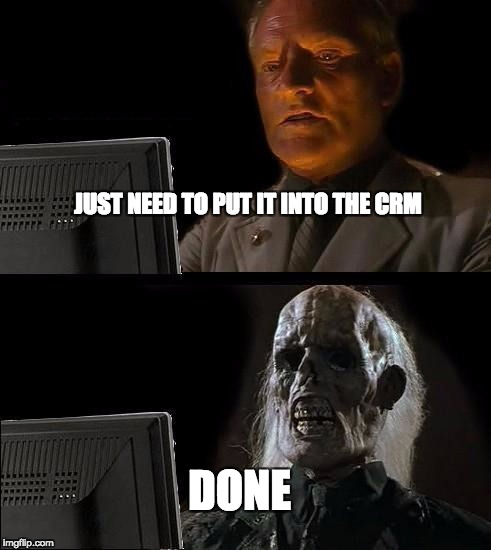
We built Salesflare as a tool that helps you without you having to help it first. Something that is more sales assistant than spreadsheet.
Going forward we’ll be using Salesflare as CRM of reference in the follow-up equation, without making the tactics exclusive to it.
Automate everything that doesn’t need you
In order to focus all of your time and talent on follow-up and building relations, you first need to get rid of everything else that’s keeping you from doing that.
Technology has matured up to the point where it doesn’t need adult supervision anymore. Take advantage of that. Have the robots take care of the robot work so you can focus on stuff that matters.
You can automate pretty much everything straight up to the point where you’re needed in the conversation. No coding required, a combination of Salesflare and Zapier will do.

Zapier allows you to connect SaaS apps to one another and make them work together in autonomous flows. The idea is pretty simple: each app has a series of triggers and series of actions. You just have to indicate which trigger of one app you want to trigger which action in the other one.
One triggered action is called a Zap. Depending on how complex the flow, you’ll need one or more Zaps to make it work.

The most relevant example here would be to automatically push leads from your meeting scheduler into your CRM.
That would look like this:
- You send out personalised emails at scale using the email workflows in Salesflare. (Want to see how? Here’s a customer showing how he uses the email workflows for prospecting.)
- In your email, you suggest them to book a meeting with you through the personal link of your meeting scheduler (like YouCanBook.me or Calendly).
- You set up Zapier to automatically create an account/company, contact and opportunity in your CRM, Salesflare. You can even automatically create a task to follow up and store some more info in custom fields or an internal note. Just use your imagination. 🤯
Now all you have to do is launch an outbound campaign and your sales pipeline will automatically fill up with leads, ready for you to follow up on them.
Of course your leads don’t have to come from email. You can also use Zapier to push leads to your CRM from forms (e.g. Typeform, Google Forms) , Facebook Lead Ads or chatbots (Collect.chat, ManyChat, Chatfuel). Browse around in our Zapier templates for inspiration.
How to win at follow-up
It’s all you from here on out.
We touched upon it before: the one superpower you need is consistency. You win the race by keeping on running, not by being fast.
How to win at following-up? Keep at it until you get a response, no matter what that response is. Getting a ‘no’ is not losing. It allows you to move on to the next one and invest your time and talents where it matters.
That’s the mindset you need to get you in the game. Now add the following 11 ingredients to the formula to become a champion of the game.
1. Execution is something, timing is everything
By ‘response’, I really mean response. Not getting an email back doesn’t count and shouldn’t stop you.
Too often sales people assume silence is a sign of rejection, while in reality it’s just bad timing.
First off, your email could have just gotten lost in clutter and confusion. Using email tracking can shed some light here. If you use Salesflare’s email sidebar for Gmail or Outlook or email from the CRM itself, it can tell you if an email has been opened or not.
Even if your recipient opened your email, there’s still multiple possible reasons other than rejection for prospects to not reply to your email:
- they’re not available (illness, travelling, personal problems)
- they’re in the middle of something else
- they just forgot to reply
Whatever it is, don’t take it personal. Assuming you didn’t get an email back because of rejection is a losing mindset. Change things up: assume the timing just wasn’t right and try again.
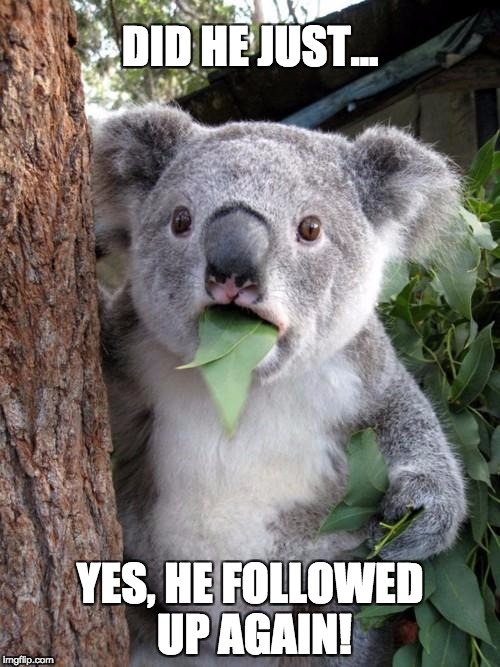
Maybe they ignored you because they’re not interested, maybe not.
The only thing you know for sure is that you don’t know. Get out of maybe-land and follow up until you do. The only outcomes you should settle for are ‘yes’ and ‘no’.
In the game of follow-up, getting a ‘no’ is not losing, it’s winning. When someone tells you they’re not interested, you can move and focus your efforts on the next prospect. The only way you can lose at follow-up is by staying stuck at ‘maybe’.
2. Chase clarity over being liked
Why is it so difficult to look beyond silence and keep on following up until you get a hold of someone?
You’re afraid of being annoying.
Well, guess what: you’re not in high school anymore. Being popular isn’t going to make your business grow. Sales are.

Put differently: aim for seven people not liking you and three people doing business with you over ten people liking you and zero doing business with you.
The seven that are turned off by you because you’re trying to bring them value don’t deserve your energy anyway. Invest that energy in the people that do matter.
3. Know when to stop
Some people do use silence to tell you they’re not interested.
As a rule of thumb, five reach-outs without a reply equals ‘no’. You can safely assume they’re not interested in the value you have to offer and invest your energy on someone else.

Another great idea may be to take a step back when it comes to the selling and ask their opinion about something first. This could just be a personal question, or it could be a bit more formal and automated by using a specialized platform for user feedback, like Mopinion, where you can gather email feedback.
4. Be present without being stalky
At what intervals should you follow up after you shot your first email?
Start off strong and decrease frequency over time. The longer a prospect doesn’t reply, the more likely it becomes the span of timing not being right is significant.
Here’s a general outline to start from:
- Day 1: 1st email follow-up
- Day 3: 2nd follow-up
- Day 7: 3d follow-up
- Day 14: 4th follow-up
- Day 25: 5th follow-up
- After: once a month
If you have established a connection with your prospect without them being immediately interested in your product, it still makes sense to follow-up with them about once a month, just to keep the relationship going. Play the long game. Your network is your net worth, you never know what benefits a connection may bear.
For cold outreach, you can easily automate this using sequences in your email automation tool.
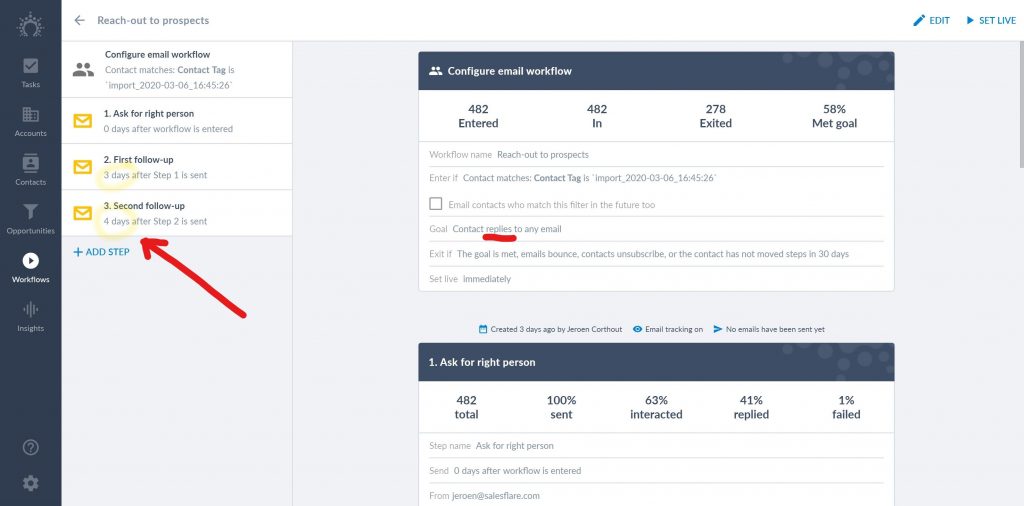
You can perfectly replicate your follow-up routine in a Salesflare email workflow and even add some flexibility to it. Say there’s a link to your calendar in your email for prospects to book a call with you: you can have the sequence break off when they click that link too.
5. Use follow-up reminders
Follow-ups aren’t just needed when doing cold outreach. You may already have made some progress with a prospect, but lines go cold again before you know it. It’s your job to keep the relationship alive. Remember: you aren’t entitled to anything.
“I don’t have to write that down, I’ll remember it.”
– No, you won’t.
Your brain isn’t a safe to store data in, there’s technology for that. There’s no way you won’t make mistakes having to keep track of following up on multiple opportunities at the same time. You’ll forget to follow up and miss out on sales.
This is where your CRM comes in. Have it tell you when you should follow up creating easy tasks and/or reminders so you can focus your brainpower on what matters: writing killer emails to build relations.
To create a task in Salesflare, use the top box in the Tasks Screen.
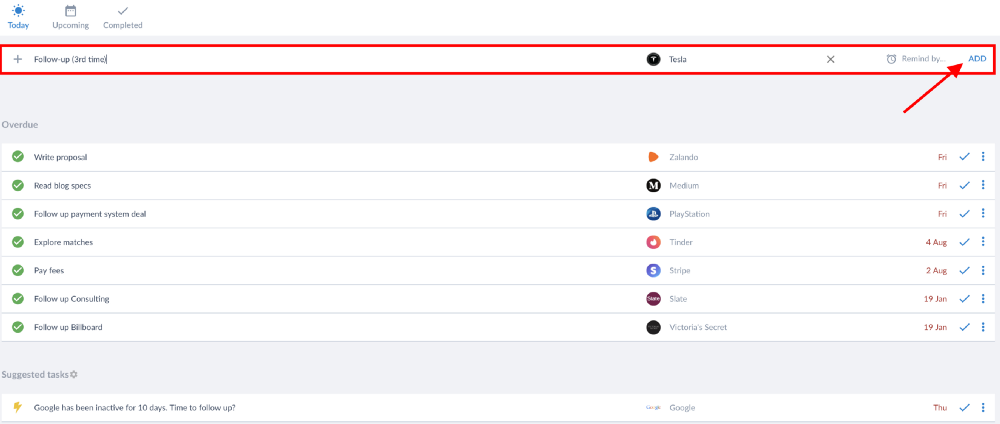
We wouldn’t be Salesflare if we wouldn’t have some automation powers up our sleeves. Next to Tasks, we’ll also make sure you keep your eyes on the ball with automatic inactivity reminders. These will be triggered after 10 days of inactivity on opportunities in your sales pipeline.
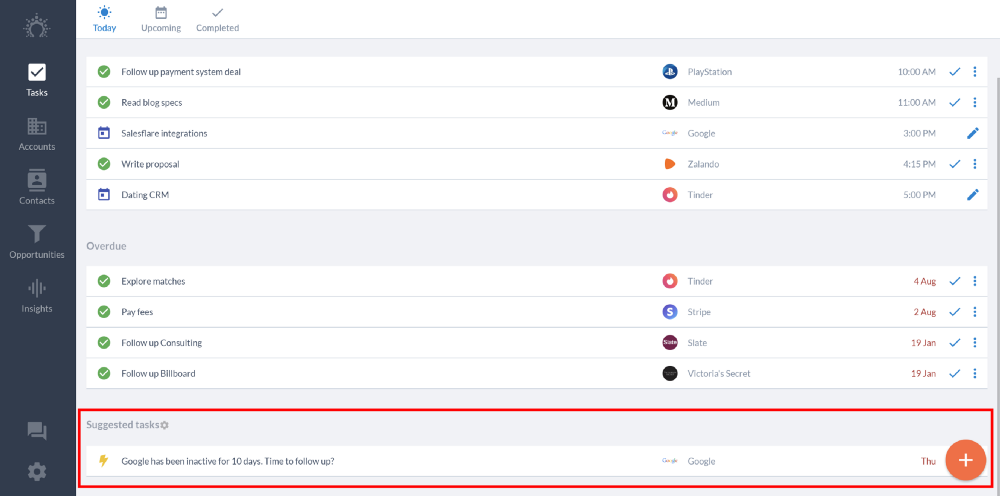
10 days is the standard setting, you can customize these timings according to the stages in your sales pipeline. Just head to Settings > Customize Pipelines, click the pencil to edit and set a custom amount of days for inactivity reminders.
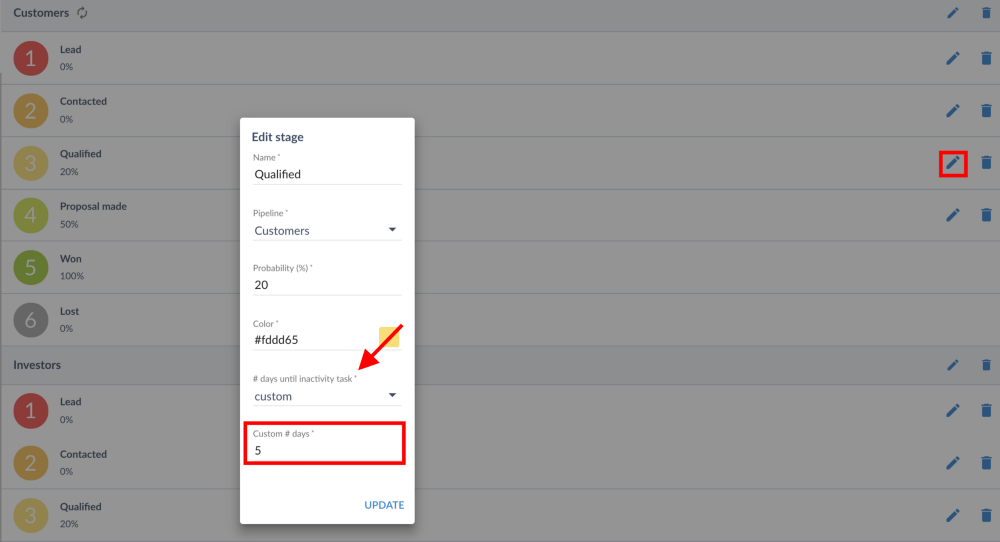
There’s even more…
In Salesflare, you’re also able to send out automatic follow-up emails based on triggers such as stage changes.
Examples:
- A lead replied to your cold email and booked a call with you. As this lead is automatically pushed from your meeting scheduler to your sales pipeline in your CRM, an email is automatically sent out to confirm the call. Make it extra special by sending over a piece of relevant content.
- The call went well and you drag the lead to the next stage in your pipeline. This triggers an email inviting your lead to your Facebook community as a way of making him feel special.
- You’ve agreed on terms with a lead and as they move to the next stage in your pipeline, an automated proposal email is sent their way.
- You’re selling Saas. A lead’s trial is expired, without him taking action to start paying. As he moves to the ‘Lost’ — stage an email is triggered to convince him to subscribe or at least extend his trial.
6. It doesn’t always have to be email
Following up and email go hand in hand, but there’s more to the story.
While email is still the backbone of business communication, other media can offer more in terms of deliverability, swiftness of response and overall effect on the prospect.
The long game: email
Email is the safe and reliable option. It allows you to gently nudge your prospect multiple times without being intrusive. You leave the prospect in control over when and how they’ll respond, but it may also take you long to really get through and reach your goals.
For a quicker response: phone call
Compared to email, a phone call is harder to ignore. People are more likely to pick up their phones than they are to reply to your email within 2 minutes.
The same reason makes phone calls more intrusive than emails. We all prefer doing things on our own time and follow-up phone calls don’t really rhyme with that. The risk of turning a ‘maybe’ into a ‘no’ is higher for phone calls than it is for emails because the chance of coming across as annoying is higher.
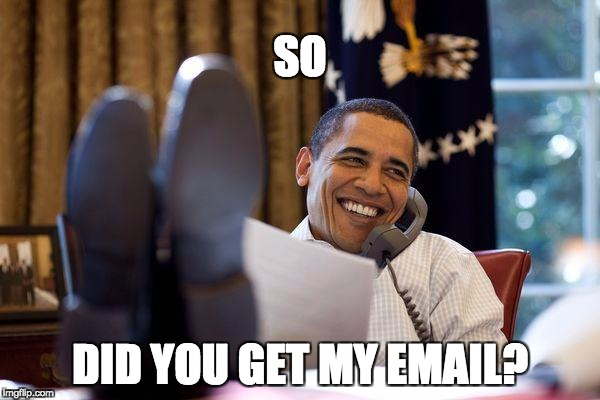
Whether you are annoying or not always comes down to you. There is a difference between calling someone once or ten times a day. The first one is called showing interest, the second one stalking. You have been warned.
You can look for VoIP phone system for businesses and utilize plenty of automated features, like auto-text replies, to make the cold calling process less time-consuming. However, we don’t have robots to do our phone calls (yet) so for now the best tactic is to set strategic reminders and use proper cold calling scripts.
The compromise: SMS
If your prospects take too long to answer emails and don’t pick up their phones, you may want to have a go at SMS. As a medium, it’s not as cluttered as email and less intrusive than phone calls, which makes it rather effective to grab your lead’s attention.
You can automate sending SMS’s to your prospects similarly to how we automated emails before, linking your CRM to one of the many available SMS sending apps with Zapier.
Welcome to the 21st century: social media
People are increasingly resorting to social media platforms and their chat functionality to communicate, not just in their personal lives. Every day, both my LinkedIn and Facebook Messenger apps are lit with new incoming messages from all over the world.
It makes sense to establish a virtual relationship on social media once you and your prospect have established a friendly first contact. Following your prospect on Twitter and connecting with them on LinkedIn will reduce the distance in your mutual relationship, especially if you can establish yourself as a trustworthy person by bringing value on these platforms.
If you don’t throw a sales pitch in their faces. But I assume you already got that by now.

Social selling works because communication on social platforms tends to be much more swift, informal and personal. Its easier to become friends here than it is via email and what do you know: friends buy from friends — people they know, like and trust.
Whether it’s chatting one-on-one or sending out little nudges by liking and sharing posts, building relations with your prospects on social media has little to no downsides — though the extent to which you can do it depends on industry, company size, role and age of the prospect. Sixty-year-old managers of big accounting firms are less likely to chat than twenty-five-year-old startup marketers.
In Salesflare, your Contacts will automatically be enriched with social media accounts so you can go from your CRM straight to their LinkedIn profiles.
For more inspiration on social selling, check out our Playbooks for LinkedIn and Facebook.
To make your prospect feel special: handwritten notes
In sales and marketing: the more a tactic is used, the more its effect will wear off. The reason email has lost its effectiveness over the years is because we get hundreds of them a day. To really grab your contact’s attention, do something that stands out.
Over time, all marketing strategies result in sh*££y clickthrough rates.
We were happy to trade in letters for email because of efficiency. Writing letters takes time, sending them possibly even more. Email was a gift from heaven for its speed, scalability and efficiency. Today, we miss handwritten letters for exactly the same reasons. There’s something special and authentic to it. Because so few are sent, getting a letter has once again became a unique experience.
It may sound counterintuitive, but you can do this at scale. Maillift is a service that will write your handwritten letters for you. They have a Zapier integration, meaning you can even automate this.
Nothing beats real life
“I was in the area, so I thought I’d drop by real quick and see what’s up.”
It’s one of the oldest tricks in the book and it’s not hard to see why.

If you want to make an impression and get the realest of responses: go down there. Do or die, there is no try.
7. Adopt a one-on-one approach
The key to winning at follow-ups or any sales/marketing tactic that involves scale and automation is to go out of your way to make your prospect feel like you’re personally involved into solving his or her problems.
This starts with your initial outreach. Don’t settle for just getting first name right, make sure your value and message are tailored to the people you’re sending emails to. Role, industry, company size and geography are all variables you can take into account when crafting your message. If you really want to take it up a notch, use a tool like CrystalKnows to find out personality types of your prospects and create different types of copy to allow your message to land in the best way possible.
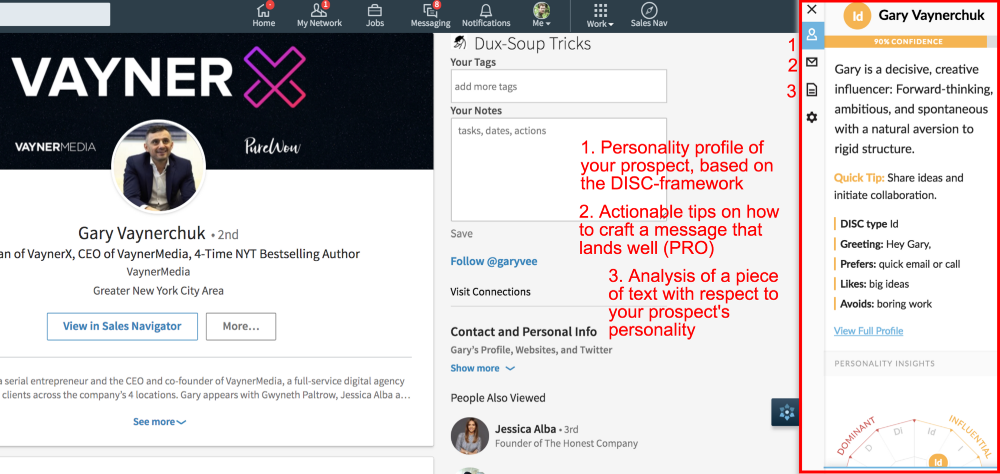
You can use Crystal’s data to create a variety of personality aligned cold emails and/or use it in your follow-ups as soon as a lead has entered your sales pipeline. If you want to know how to automate sourcing personality data from LinkedIn profiles with Crystal, hit me up on Messenger.
From the moment you’re in follow-up mode, it’s all about context. Getting this right takes all the empathy and diligence you can bring to the table.
Whether you follow up two or seven times, whether you do it every day or every week, whether you stick to email or use a variety of media — it all depends on the situation your prospect is in plus the relationship and interactions you had with him/her. It’s all about context.
You don’t follow up with a CEO of a Fortune 500 company the same way you do with a millennial marketer of a SaaS startup. The first one gets thousands of emails everyday, the second one will probably reply within ten minutes and then send you a connection request on LinkedIn.
8. Keep it short, sweet, slick, succinct and specific
Don’t waste time. Not yours and not your prospect’s.
We know you’re in love with your product but describing why in three long-winded paragraphs isn’t going to make your prospect get that same feeling. They may not even end up reading it. When I open an email and see a chunk of text, my reflex is to trash it instantly. Can’t help it, it just happens.
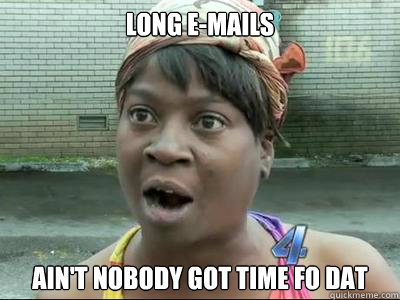
You can’t force nor control people’s feelings and convictions. Overtly losing yourself in product pitches shows a lack of empathy and will throw your prospect off rather than draw them in. Get to the point, address the pain or problem they’re struggling with and show how you can solve that in a way that triggers their curiosity.
This little interaction here is not about you, it’s about them and how you can help them. Dedicate your words to a story that has your recipient as the hero and make it compelling enough for them to want to know what comes next — make them click that CTA that sees them going to your website or schedule a call with you.
9. Help your prospect move forward with Call-To-Actions
CTA’s are crucial to ensure a steady flow going back and forth. You should have a goal with every follow-up email you send and make it easy for your prospect to get in on that goal. It’s not up to them to make out what comes next.

Trigger them to start your trial, offer a download of your latest ebook, send a link to your calendar, invite them into your Facebook group. You should have a clear idea of what you want to achieve at what stage of the sales funnel and have specific CTAs to induce your prospect to move up in that funnel.
10. Add a pinch of funny
Few things in this world are as contagious and connecting as good humour.
If you yourself have been followed up on before, you know how little impact the one millionth ‘just checking in’ email has. But what if the person on the other side adds in Spongebob Squarepants to break through the boredom.

Or this impatient giraffe.

The best example of a funny email follow-up I’ve ever come across, is the baby ducklings email:
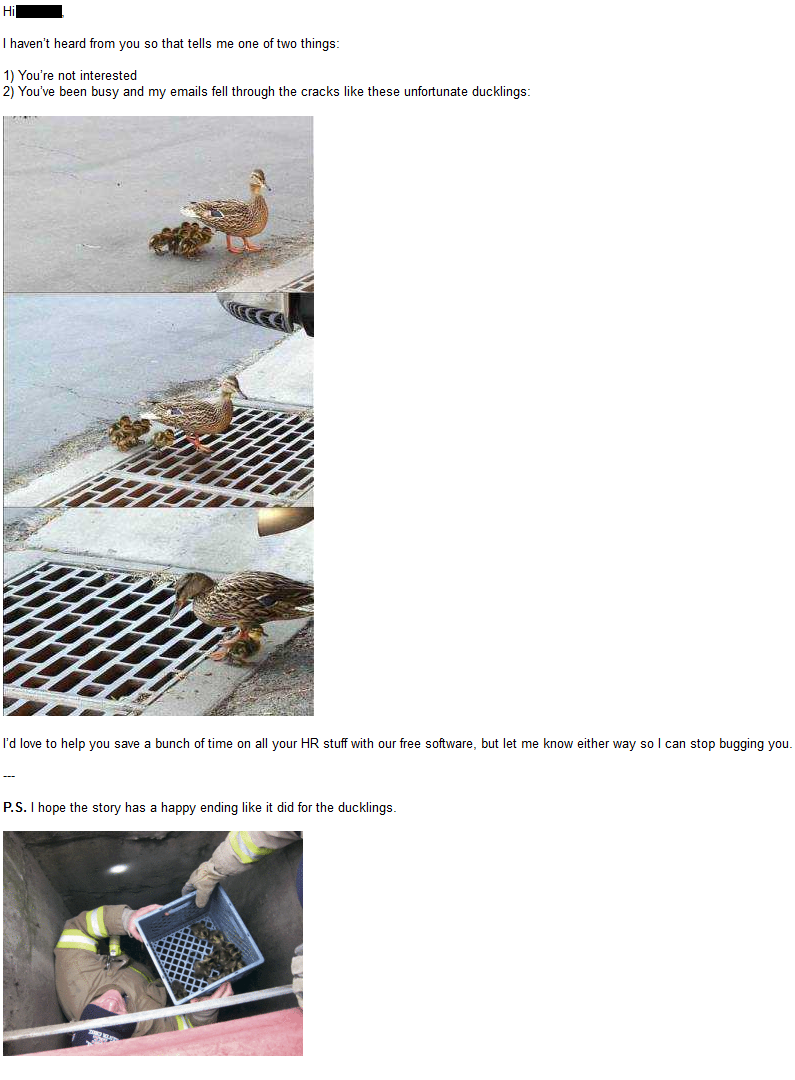
There’s tons of stuff you can do with GIFs, memes and just good old copy. Just get creative and see what sticks.
Making someone laugh is the shortest way to connecting with someone, it will set you apart from every ‘just making sure you’re still interested in this’ email out there.
11. Put on your prettiest virtual smile at all times
For most people, their email inbox is a never-ending flow of frustration. Overflowing with unread emails, it’s a never-ending to-do list.
Don’t fuel their feeling of unease by calling them out on not responding to you. Stuff like ‘I’ve already sent you 3 emails’ or ‘just tell me you’re not interested already’ will only backfire. Your prospect likely already feels guilty for not replying to you, making them feel extra bad about it isn’t going to turn the situation around.
Change things up and approach this feeling of anxiety as an opportunity. Be the bigger man and just act indifferent to having been ‘ignored’ before. Keep on giving off a vibe of positivity and availability. Your prospect will develop positive feelings towards you if you can make them feel comfortable when before they felt anxious.
Treat every interaction as a new chance to establish a relationship by being persistently positive.

Recap
Whether you’re doing it on cold leads or throughout your sales process: following up will get you more sales.
- Actually doing it is the single most important thing. Don’t take silence for rejection. The game can only end with ‘yes’ or ‘no’. Everything else is you giving up.
- To do more, automate everything that doesn’t need your human touch and use an efficient CRM tool so you can stay on top of your game. Every single prospect deserves your uttermost patience, empathy and availability and you can’t give them that if you’re stuck doing mindless admin work the whole time.
- Stay on top of your game but know when to stop. Three times silence doesn’t necessarily equal rejection, but five times most likely does. It’s not about you not annoying your prospect, it’s about dedicating your time to more qualified ones
- Decrease the frequency of your emails as time progresses. If your prospect hasn’t replied to the first three email follow-ups in a week, they’re likely not in the situation to connect with you at that time. Sending a fourth email shortly after will rather annoy them than change things up.
- Do play the long game though. As the saying goes: your net worth is your network. Even if your value is not immediately relevant to a prospect, you never know how you can help each other in the future. Meaningful relationships will get you ahead, in business and in life.
- Don’t trust your brain to remember when to follow up, it will fail you. Set follow-up reminders instead and automate routine emails altogether.
- Use your brain to get through with your prospect. Figure out what makes them tick, craft your message to fit their unique case and use humor to stand out of the noise. Guide them throughout their own narrative and towards intermittent goals.
- Finally, don’t limit yourself to email to build rapport with some. There’s so much more.
The person on the other side is a human being just like you. If you’re able to put yourself in their shoes and provide relevant value, you shouldn’t let anything discourage you from following-up. Never feel bad for being in the business of helping people.
Want to see more ways to use email automation? Check out these video use cases for email workflows made by our customers.
Last updated:
- The 20 Best Sales Books Elon Musk Is Probably Reading - February 14, 2023
- 6 foolproof ways to get your startup its first 100 customers - December 6, 2022
- How To Build A Sales Funnel That Sells - September 2, 2021
